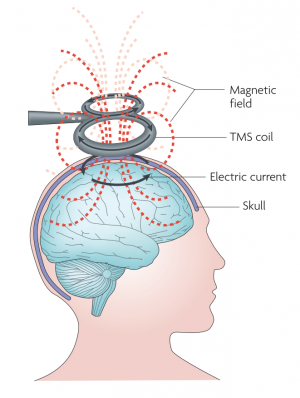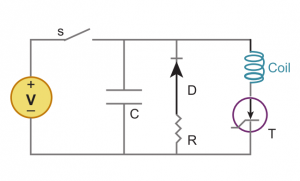Difference between revisions of "Transcranial magnetic stimulation"
(summary) |
(added annotation to the schematics picture) |
||
| Line 7: | Line 7: | ||
== Main characteristics == | == Main characteristics == | ||
| − | [[File:TMS 2.png|thumbnail|right|A simplified circuit diagram of a single-pulse magnetic stimulator.]] | + | [[File:TMS 2.png|thumbnail|right|A simplified circuit diagram of a single-pulse magnetic stimulator. (V = voltage source, s = switch, C = capacitator, D = diode, R = resistor, T = thyristor)]] |
The magnetic field created by the the coil produces electrical current in the brain of the subject due to the electromagnetic induction effect. This produces secondary ionic current which activates the near-surface neuronal axons in the target area. However, TMS, especially in higher intensities, may activate any neuron along the way.<ref name="rid07" /> The magnetic field can reach up to 2 T and usually lasts for about 100 µm.<ref name="primer" /> | The magnetic field created by the the coil produces electrical current in the brain of the subject due to the electromagnetic induction effect. This produces secondary ionic current which activates the near-surface neuronal axons in the target area. However, TMS, especially in higher intensities, may activate any neuron along the way.<ref name="rid07" /> The magnetic field can reach up to 2 T and usually lasts for about 100 µm.<ref name="primer" /> | ||
Revision as of 08:23, 24 March 2016
Transcranial magnetic stimulation, or TMS, is a non-invasive method of brain stimulation. During the procedure, a magnetic coil is placed over the scalp of the person receiving the treatment. The magnetic field penetrates the skull and the electric stimulus activates the neurons in the target area. This can be used to explore how the brain works, by disrupting its normal behaviour with the stimulation, or, in the case of repetitive stimulation, to modulate the brain activity for therapeutic purposes.[1][2]
Magnetic stimulation is used for mapping the human brain, mainly the primary motor cortex because the reaction of the body to the stimulus is easily observable. This is how the location of brain functions of the brain were localized, first for the motor functions, by measuring the motor evoked potentials in the muscles, and now it is possible to localize cognitive and sensory processes with TMS as well.[3]
It is also used as a treatment for major depression. Two TMS devices, NeuroStar TMS Therapy system from Neuronetics,[4] Inc., and Brainsway Deep TMS system[5] have been approved by the U.S. Food and Drug Administration for the treatment of depression[1] One session usually lasts 30 to 60 minutes.[6] for which TMS is a cost-effective alternative as opposed to antidepressants.[7][3]
Contents
Main characteristics
The magnetic field created by the the coil produces electrical current in the brain of the subject due to the electromagnetic induction effect. This produces secondary ionic current which activates the near-surface neuronal axons in the target area. However, TMS, especially in higher intensities, may activate any neuron along the way.[2] The magnetic field can reach up to 2 T and usually lasts for about 100 µm.[3]
TMS system is composed of two parts. A high-voltage charge-discharge component that produces the required current waveform. This is a RLC circuit modified so it produces the waveform with the lowest amount of heat generated. The second components is the current carrying coil that servers as the emitter of the magnetic field. Although the design of the coils vary, the most used are two circular coil in parallel so as they resemble the number eight, or butterfly, shape. The coils are made of copper wiring and enclosed in a plastic chassis, with the diameter ranging from 4 to 9 centimetres.[8][9]
Purpose
Company & People
Important Dates
Enhancement/Therapy/Treatment
Ethical & Health Issues
Public & Media Impact and Presentation
Public Policy
Related Technologies, Projects or Scientific Research
References
- ↑ 1.0 1.1 ELDAIEF, Mark C., PRESS, Daniel Z. and PASCUAL-LEONE, Alvaro, 2013, Transcranial magnetic stimulation in neurology A review of established and prospective applications. Neurology: Clinical Practice. 2013. Vol. 3, no. 6, p. 519–526. DOI 10.1212/01.CPJ.0000436213.11132.8e.
- ↑ 2.0 2.1 RIDDING, Michael C and ROTHWELL, John C, 2007, Is there a future for therapeutic use of transcranial magnetic stimulation? Nature reviews. Neuroscience. 2007. Vol. 8, no. 7, p. 559–567. DOI 10.1038/nrn2169.
- ↑ 3.0 3.1 3.2 HALLETT, Mark, 2007, Transcranial Magnetic Stimulation: A Primer. Neuron. 2007. Vol. 55, no. 2, p. 187–199. DOI 10.1016/j.neuron.2007.06.026.
- ↑ https://neurostar.com/
- ↑ http://www.brainsway.com/about-brainsway
- ↑ http://www.nimh.nih.gov/health/topics/brain-stimulation-therapies/brain-stimulation-therapies.shtml
- ↑ NGUYEN, Kim-Huong and GORDON, Louisa G, 2015, Cost-Effectiveness of Repetitive Transcranial Magnetic Stimulation versus Antidepressant Therapy for Treatment-Resistant Depression. Value in health : the journal of the International Society for Pharmacoeconomics and Outcomes Research [online]. 2015. Vol. 18, no. 5, p. 597–604. DOI 10.1016/j.jval.2015.04.004. Available from: http://www.sciencedirect.com/science/article/pii/S1098301515019270
- ↑ WAGNER, Timothy, VALERO-CABRE, Antoni and PASCUAL-LEONE, Alvaro, 2007, Noninvasive human brain stimulation. Annual Review of Biomedical Engineering [online]. 2007. Vol. 9, no. 1, p. 527–565. DOI 10.1146/annurev.bioeng.9.061206.133100. Available from: http://dx.doi.org/10.1146/annurev.bioeng.9.061206.133100\nfiles/392/Wagner et al. - 2007 - Noninvasive Human Brain Stimulation.pdf
- ↑ KOBAYASHI, Masahito and PASCUAL-LEONE, Alvaro, 2003, Basic principles of magnetic stimulation. The Lancet. 2003. Vol. 2, p. 145–156. DOI 10.1016/S1474-4422(03)00321-1.

